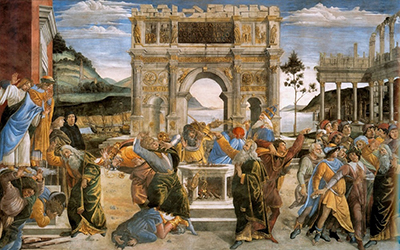Punishment of the Rebels is a wide fresco from Sandro Botticelli that sits in the Sistine Chapel
It was around 1480 that Florence and Rome were to seek friendlier ties through the exchange of art. The finest Florentine artists, including Botticelli, were sent to Rome to work on various internal displays in the Sistine Chapel.
Lorenzo de' Medici and Pope Sixtus IV hoped to improve the relationship between these two powerful Italian Papal States through further communication from that point onwards. Pietro Perugino was another significant member of this group, though many more members from their studios would also make the trip in order to ensure this politically-sensitive project was delivered successfully.
As is the case with several other Botticelli frescos, this artwork has been given several different titles, such as The Punishment of the Sons of Corah. The final panel is over three metres wide which is necessary in order to fit three different scenes in.
Internal installations would often have multiple scenes together, as if telling a story. In this case, the religious theme was of punishment for going against the word of God, making this painting a clear threat to those looking to rebel against either God or his designated representatives, i.e. the Pope. A significant strand to this is that the power of the papacy was being questioned at the time of this painting.
Artist Botticelli's work on this project was severely hampered by the death of his father, forcing him to return to Florence and leave his studio assistants to complete the work. He had achieved enough by that point to be able to confidently hand over the remaining work to his support staff.
To do this day his largescale artwork remains on display in the Sistine Chapel, in the fifth compartment on the south wall. This building has a wealth of art to enjoy from the Italian Renaissance, when the Papal States dominated the art world right across Europe.
The content and symbolism found within the Punishment of the Rebels held deep importance both politically and also from a religious sense. At this time these two topics were deeply intertwined, virtually inseparable. The stories of Moses and Christ were being drawn together to show continuity between the Old and New Testament. Sculptor Michelangelo famous produced this Moses statue.
The Punishment of the Sons of Corah, as some refer to it, tells us of trouble between the Hebrews and Moses with Aaron. Moses is protected by Aaron from the Hebrew rebellion which aims to stone him to death. The central rebellion concerns the Korah, against dealt with my Moses and Aaron. Punishment is served on the left hand side of this wide panel as the worst offenders disappear without trace. The overall cycle of life of Moses is captured in the Sistine Chapel, with this just being one element of that.




